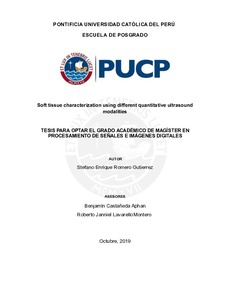| dc.contributor.advisor | Castañeda Aphan, Benjamín | |
| dc.contributor.advisor | Lavarello Montero, Roberto Janniel | |
| dc.contributor.author | Romero Gutierrez, Stefano Enrique | es_ES |
| dc.date.accessioned | 2019-10-25T00:42:02Z | es_ES |
| dc.date.available | 2019-10-25T00:42:02Z | es_ES |
| dc.date.created | 2019 | es_ES |
| dc.date.issued | 2019-10-24 | es_ES |
| dc.identifier.uri | http://hdl.handle.net/20.500.12404/15255 | |
| dc.description.abstract | Quantitative ultrasound has been used in several modalities for different experiments such as simulated
phantom, physical phantoms, ex vivo and in vivo tissues. The potential of the ultrasound techniques
could be useful to complemented medical diagnosis. In this work, two quantitative ultrasound techniques
are applied on in vivo experiments: crawling waves sonoelastography applied to bicep brachii and a
regularized power law for backscattering and attenuation coefficient for ovary tumor.
A crawling waves sonoelastography (CWS) method was applied using two mini-shakers making parallel
contact (conventional setup) and normal contact with the surface in two phantoms (homogeneous
and inhomogeneous) using the phase derivative algorithm to assess the performance of the normal excitation
with well-know metrics such as error, coefficient of variation, signal-to noise ratio and contrast-to
noise ratio. The results suggest that the normal excitation provides comparable stiffness estimation in
homogeneous and inhomogeneous phantoms. For in vivo test, a bicep barchii from healthy volunteers
were assess in two experiments: relaxed-contracted and with a range weight of load. The application
of normal setup indicated that a measurement of the relative stiffness on bicep brachii can be realized.
The results indicated that a using the incremental weight causes a increase on the stiffness of the bicep
following a linear behavior.
A regularized power law (RPL) method was implemented and testing with simulated phantoms using
a combination of the possible variables of data block size and the regularized parameters of the three
variables of the backscattering and attenuation coefficients. The results showed that is possible provide
accurate and precise backscattering and attenuation coefficient in the same algorithm. Additionally, in
vivo breast experiments was performed and compared with the literature obtaining comparable results.
Finally, a tumor of patients with suspected ovarian cancer were assess. The results suggests that RPL
method and in general provides reasonable depictions of the reflectivity and attenuation of interrogated
media. | es_ES |
| dc.description.uri | Tesis | es_ES |
| dc.language.iso | eng | es_ES |
| dc.publisher | Pontificia Universidad Católica del Perú | es_ES |
| dc.rights | info:eu-repo/semantics/closedAccess | es_ES |
| dc.subject | Ultrasonido | es_ES |
| dc.subject | Ingeniería de tejidos | es_ES |
| dc.subject | Cáncer--Diagnóstico por imágenes | es_ES |
| dc.title | Soft tissue characterization using different quantitative ultrasound modalities | es_ES |
| dc.type | info:eu-repo/semantics/masterThesis | es_ES |
| thesis.degree.name | Maestro en Procesamiento de Señales e Imágenes Digitales. | es_ES |
| thesis.degree.level | Maestría | es_ES |
| thesis.degree.grantor | Pontificia Universidad Católica del Perú. Escuela de Posgrado | es_ES |
| thesis.degree.discipline | Procesamiento de Señales e Imágenes Digitales | es_ES |
| renati.advisor.dni | 10791304 | |
| renati.discipline | 613077 | es_ES |
| renati.level | https://purl.org/pe-repo/renati/level#maestro | es_ES |
| renati.type | http://purl.org/pe-repo/renati/type#tesis | es_ES |
| dc.publisher.country | PE | es_ES |
| dc.subject.ocde | https://purl.org/pe-repo/ocde/ford#2.02.05 | es_ES |





